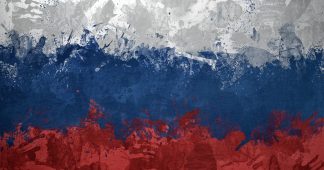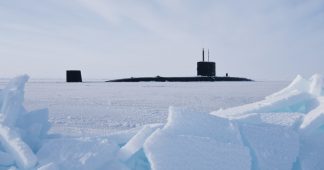Posted on
Washington’s hypocrisy and the frontiers of its New Cold War (of choice) appear to know no bounds. Eastern Europe is the classic theater of course, but you’ll hear the Pentagon’s new buzzword-acronym priority purpose, “great power competition” (GPC) – etched in senseless stone with the 2018 National Defense Strategy (NDS) – peddled to justify military missions in the Middle East, Central and East Asia, across Africa, and now at the very “roof of the world:” the frigid Arctic. Hey, it’s hard to think of a better setting for a Cold War, am I right? At least if you’re into playing what the impressively, and surprisingly, snarky activists at Greenpeace dubbed “NATO roulette!”
Washington’s bipartisan hawk herd – who’ve never a met a hot or cold war they didn’t love, and label essential – along with their Euro-enabler/cheerleaders in Brussels, would have you believe that the Russkies are set to march straight over the North Pole, ransack Santa’s workshop en route for good measure, and force (or fulfill the not-so-secret dream of) every red-blooded American patriot to live out a real life Red Dawn rebellion against their new Moscow-masters. It sure would make for an historically cinematic blockbuster – but is that what’s really going on here? Come on, is it even necessary to ask that after 20 years of U.S. foreign policy absurdity – and the omissions, obfuscations, and untruths used to sell it? No, no: once again, Washington’s wolf-criers are preying on Americans’ anxiety, apathy, and ignorance to sell another snake oil strategy that ensures abundant sales for their war industry-overlords.
The general alarmist fantasy goes something like this: To start with, Moscow is a malign actor, always and ever, by its very nature. Plus, ever since Putin pulled into the Kremlin, the Russians had been biding time, until they pounced mightily around 2014 (Ukraine, Crimea, Syria, etc.) – and haven’t stopped since. What’s more, like the a Slavic Sauron in Moscow-Mordor, Vlad-the-Terrible also had his eyes fixed firmly on the Arctic. So, once a warming climate began melting some polar ice, the Russians streamed into the region with nuclear-powered ice breakers to steal its minerals, create military avenues of approach for an assumed outward onslaught, and has just loaded the northland with the countless troops, ships, and planes needed to pull off the conquering coup conspiracy. Spooky stuff, I know.
None of it’s strictly true of course – all of it’s exaggerated, plenty plain false, some sheer farce. But it sure plays well in the America’s capital city theater!
More alarming still is that these Arctic-alarms are apt to be raised most loudly by the party of polite-imperialists currently keeping the throne warm in Washington. Think about it: the scenario contains all the favored ingredients for a frozen (non-)crisis cocktail most appealing to the Democratic establishment – “security impacts of climate change,” a meddling Moscow menace, and tech-savvy “solutions.” In other words, if things go south up North Pole way, we won’t be able to blame the naughty-as-ever Republicans and place our hopes on the voters picking a preferable party off Santa’s nice-list.
Debunking the Delusions
At the end of the near perfect modern Hollywood Western Tombstone, Val Kilmer – in an actually perfect performance as famed gunfighter and notorious vice-enthusiast Doc Holliday – delivers a stellar line to legendary lawman Wyatt Earp after Holliday (a decided skeptic) receives last rites from a Catholic priest: “It appears my hypocrisy knows no bounds.” Well, when one lives the life – for his sins – of a careful US foreign policy watcher, it’s hard not to wish Washington had half the self-awareness and self-deprecating wit of the fictional tubercular anti-hero. Unfortunately, the people parsing policy in America’s real-life Emerald City haven’t the slightest sense of irony and take themselves – and their dedicated delusions – far too seriously. That’s perhaps most troublingly true with regard to Uncle Sam’s biggest blind spot – an irrationally obsessive antagonism towards Russia; and it sure as heck applies in the Arctic.
Nonetheless, facts – and backstory, context, and contrast – still matter, at least if sober strategy remains the actual goal (a bigger and bigger big-if, these days). So, for the sake of simplicity and clarity, let’s take a critical look at each of Russia’s ostensible Arctic aggressions in sequence:
- Russia has upped its military spending, number of active bases, and equipment/resource-commitment to the Arctic: Well, sure – it seems it has, but…let’s say there’re a lot of buts here. That, and enough US hypocrisy to fill a few Arctic-icebreaker fleets. For example, America’s own Alaskan Arctic has long been one of the most militarized places in this militarized nation – that absurdly non-contiguous state already draws a rather significant portion of Pentagon spending, and is home to no less than nine US Army and Air Force bases. Furthermore, while there’s been ample alarm about Russia reoccupying Cold War-era bases (on their own sovereign territory) – “They’re opening up Soviet military facilities in the Arctic,” per NATO Secretary-General Jens Stoltenberg’s context- and contrast-free March 2021 statement – America’s frigid martial installations actually reach into foreign territory.
For example, the northernmost US military site, Thule Air Base in Greenland, which sits a full 1,207km above of the Arctic Circle, comes to mind. So does Orland Air Base in central Norway, where the US recently stationed an “expeditionary” – not a particularly defensive title, that – B-1B bomber squadron and more than 200 airmen. Moreover, as to the whole Chicken Little act about the sky-falling ramifications of the Russians refurbishing and reopening old “Soviet military facilities” (on their territory), it bears noting that the Norwegians have also improved the port facilities at Tromso, some 190 miles above the Arctic Circle, “to clear the way for increased visits by US nuclear submarines, providing a major new jumping off point for watching Russia’s active Northern Fleet.”That’s no small thing: given that this is the first time American bombers have deployed to Norway. Oh, and to round out the whole land-sea-air component of the Pentagon’s vaunted “multidimensional” joint force, recall that US Marines have trained there regularly since 2017. The passing comment of a Business Insider report – “Russia is likely to regard a bomber deployment to Norway warily” – must count as the understatement of the year.
- In 2020, Moscow “dropped paratroopers into a high-Arctic archipelago to perform a mock battle,” according to the New York Times: True enough. Then again, that oh-so menacing Russian airborne training operation went down in April 2020, and hardly leapt over some strategic Rubicon – rather, it built upon similar missions conducted over the preceding six years. Furthermore, its not as though the Kremlin’s alone in the Arctic airdrop exercise game – American airborne infantrymen conducted their first comparable jump (in northern Alaska) the very same year (2014) as the inaugural Russian leap of frigid faith. Plus, the US has done additional drops every year since. And of course, in a far broader sense, the US military rains – though rarely literally these days – its far more plentiful paratroopers into foreign (typically African and Mideast) drop zones a’plenty, places where people actually live (and often kills some of those for good measure).
- Russia has also created a new administrative and operational military command for the Arctic and written fresh regional strategy documents describing its ambitions there. Yes, indeed they have. Only, one can’t help but ask – pot, meet kettle – isn’t that exactly what the US does and how the Pentagon organizes its military units? Only Washington does so not only on its own sovereign territory – which is covered by only one (NORTHCOM) of its six geographic combatant commands (well seven if one includes the new Space Command, SPACECOM) – but across every square inch of the earth.
As to Moscow’s supposedly scandalous Arctic strategy document, well – the US military wrote a few too. The Air Force, which has the military’s largest regional presence, published its first last summer. Then, this January, the Navy released a report, “A Strategic Blueprint for the Arctic,” calling for a “sustained” naval and Marine Corps “presence” in far north waters to counter Russia and China. Finally, the ever-lumbering Army brought up the rear, releasing its own report,”Regaining Arctic Dominance” (Hmm, I wonder how the term “dominance” would play here if Moscow muttered it?) just last month.
In speaking about his service’s report, then Navy Secretary Kenneth Braithwaite even offered this audacious analogy: “It’s sort of the same situation in the South China Sea…when we look at freedom of navigation operations.” Well, in a way this obtuse fellow is correct: in both scenarios the US provokes powerful “adversaries” and unnecessarily risks catastrophic war several thousand miles from home – all to ensure no other country is allowed even local naval primacy in their nearest of near abroads. American military strategy: shrewd as ever!
- Per the same New York Times report, Russia has also “repeatedly flown bombers to the edge of US airspace:” Did they now? What kind of monsters are they? Well, according to a far more astute analysis by Tom Dispatch’s Michael Klare – they’re the same breed of ogre as us, apparently. Klare recounted just some highlights from a recently revived pattern of the US bombers doing – you guessed it! – the same sort of thing. In one instance, in late August 2020, he noted that six US B-52H Stratofortress bombers, amounting to one-seventh of the war-ready US fleet – each of them capable of carrying eight AGM-86B nuclear-armed, air-launched cruise missiles (ALCMs) – spent several weeks flying practice missions right “to the edge of Russian territory.”Furthermore, the next month, September, two B-1B Lancers flew straight over the North Pole to Greenland. Then, in late February, those B-1 bombers the U.S. Air Force recently stationed in Norway, flew their first missions over the Norwegian Sea. But have no fear, Russia, General Steven Basham, deputy commander of Air Forces in Europe/Africa, said “There should be no message of a threat,” because, “This is how professional militaries increase their level of expertise.” I bet that offers Russians real comfort.
The entire US regional strategy and resultant Arctic arms-race risks becoming a self-fulfilling security dilemma prophecy. The security dilemma describes a common concept in political science, whereby actions taken by one state to improve its own security causes reactions from other states, which counterproductively causes a decrease in the original state’s security. Given the mutual misreads, plus the West’s and Washington’s standard opportunistic overreactions, the Arctic seems a perfect proving ground for such a (death) spiral. All in all, a July 2020 Business Insider headline proved plenty on-the-nose for my taste: “Russian and NATO militaries are getting more active in the Arctic, but neither is sure about what the other is doing.” What could go wrong?
Do As We Say, Not As We Do
As ever, critical analysts must look to the language – in this case the adjectives so breezily tossed about to describe Moscow’s must-be-malign intentions in the Arctic. Highlights include: Russia’s “aggressive conduct” (Defense Secretary Lloyd Austin), “increasingly assertive position” (France 24 News), “significant threat” (Center for Strategic and International Policy), “military challenge” (senior State Department official), and “saber-rattling” (from a Carnegie Endowment for International Peace research paper, funded by the Russia Strategic Initiative (RSI) – a US Department of Defense organization).
But what of the view from (gasp!) Moscow – might they have (double gasp!) genuine interests and legitimate claims in the Arctic region? And could they view various US and NATO policies and reactions as significant security threats? The answer, though its increasingly impolite – if not downright un-American – to dare say so, is of course and naturally, respectively. A few basic ones leap forth: Russia has the world’s longest (24,000km) Arctic coastline; it counts on the region for nearly one-quarter of its GDP (by contrast, less than a third of one percent of US GDP comes from the Arctic), and roughly 2 million Russian citizens live there. Furthermore, Moscow remains an active member the Arctic Council, the Arctic Coast Guard Forum (ACGF), and sundry scientific and environmental treaties.
Militarily speaking, Moscow understandably feels a need to secure its second-strike nuclear capacity, which mainly rests on its nuclear submarine fleet – the bulk of it based around the Kola Peninsula, bordering northern Norway and Finland. Even a lay knowledge of that oft-absurd, but somehow still relevant, human-peculiarity known as “nuclear strategy,” demonstrates the perceived importance of a country’s confidence in that second-strike option. In other words, if a nuclear nation thinks its adversary can wipe out its “second-strike” counterforce – thereby rendering retaliation, and therefore the presumed suicide-pact deterrent of “mutually assured destruction, impossible – the weaker state may start to think a surprise “first strike” its most prudent, if not only, strategic option. It’s all nutso, naturally – but it’s almost gone down more than a few times: at which point its Dr. Strangelove time here on Planet Hollywood-Earth.
Furthermore, and here’s the real rub, when it comes to the presence of more conventional Russian troops around its Arctic perimeter, as Lyle Goldstein – a research professor at the US Naval War College – so poignantly put it: “One can hardly accuse the Kremlin of ‘aggression’ when its small deployments have all been to its own territories.” Nonetheless, such pesky facts and that vague sense of proportion aside, the American hegemon-aspirant’s professional power-brokers parent a petulant world according to the toxic mantra: Do as I say, not as I do!
The rhetoric from Washington has long matched – or exceeded – Moscow’s presumed pugnaciousness. Take Trump’s Secretary of the Navy (and Irony-Anemia) Braithwaite. In early January, just after the release of the Navy’s Arctic “Strategic Blueprint,” he dropped this bombastic bombshell on unwitting reporters: see, his service’s new game plan involved more active freedom of navigation patrols close to Russian territory, he said, because “That’s the more bold posturing that we feel is our right, and our responsibility, frankly, as the predominant naval force in the world.” Wow, that is bold – to unapologetically heave up hyperbole like “our right” to be “predominant” on the world’s seas. He actually admits, brags even, about his navy’s “posturing” – a term other hawks use to decry Russia’s supposed actions! Do as I say, not…and all, I guess.
After just one of many Arctic naval excursions in August 2020, the joint U.S.-U.K. anti-submarine Dynamic Mongoose exercise – which just so happened to occur near Moscow’s key nuclear submarine base on the Kola Peninsula – the commander of the USS Ross bragged that: “The realistic and relevant training we are conducting here in the Barents [Sea]…proves we can operate anywhere in the region with our allies.” And the Russians are the only “provocative” ones? I mean, do these guys hear themselves? OK, here’s a tip to spice things up in the battle-avoidance bedroom: try some role-play and listen to Washington’s warlike whispers wearing Russian ears (PS: “Nuclear Winter” seems a solid safe-word!).
You know, every once in a while – without even realizing it – America’s top generals say something sensible. Take Lieutenant General David Krumm, commander of the multi-force Alaskan Command and the 11th Air Force. At a 2020 convention of the Alaska Federation of Natives – many of whom actually reside in the contested region’s remote villages – he talked about how climatic-warming that’s melting once impassable ice belts removes buffers between the US and Russia, and of course proceeded to the obligatory Pentagon pitch for more money to equip and train his troops. Standard stuff, really. Only then he did some inadvertent truth-telling – waxing nostalgic for a not-too-bygone time when Alaska was viewed mainly as a global power-projection base, and noting how what he considers Russian Arctic aggression portends a changing mission for his command.
“What we have to do now is be prepared to fight here and defend here,” the good general firmly declared. And the thing is, he’s right – if for all the wrong reasons. Yes, general: prepare to fight and defend (for an attack that’s got near-zero chance of coming) here – at home, in Alaska – not (as you seem to prefer) 3,000 miles over the Arctic icecaps in Russia’s Barents Sea backyard, or “projecting power” willy-nilly across the world. That’s how the US gets itself – and everyone else – in trouble.
It’s high time to guard our own glaciers for a change!
* Danny Sjursen is a retired US Army officer, senior fellow at the Center for International Policy (CIP), contributing editor at Antiwar.com, and director of the new Eisenhower Media Network (EMN). His work has appeared in the NY Times, LA Times, The Nation, Huff Post, The Hill, Salon, The American Conservative, Mother Jones, Scheer Post and Tom Dispatch, among other publications. He served combat tours in Iraq and Afghanistan and later taught history at West Point. He is the author of a memoir and critical analysis of the Iraq War, Ghostriders of Baghdad: Soldiers, Civilians, and the Myth of the Surge and Patriotic Dissent: America in the Age of Endless War. Along with fellow vet Chris “Henri” Henriksen, he co-hosts the podcast “Fortress on a Hill.” Follow him on Twitter @SkepticalVet and on his website for media requests and past publications.











